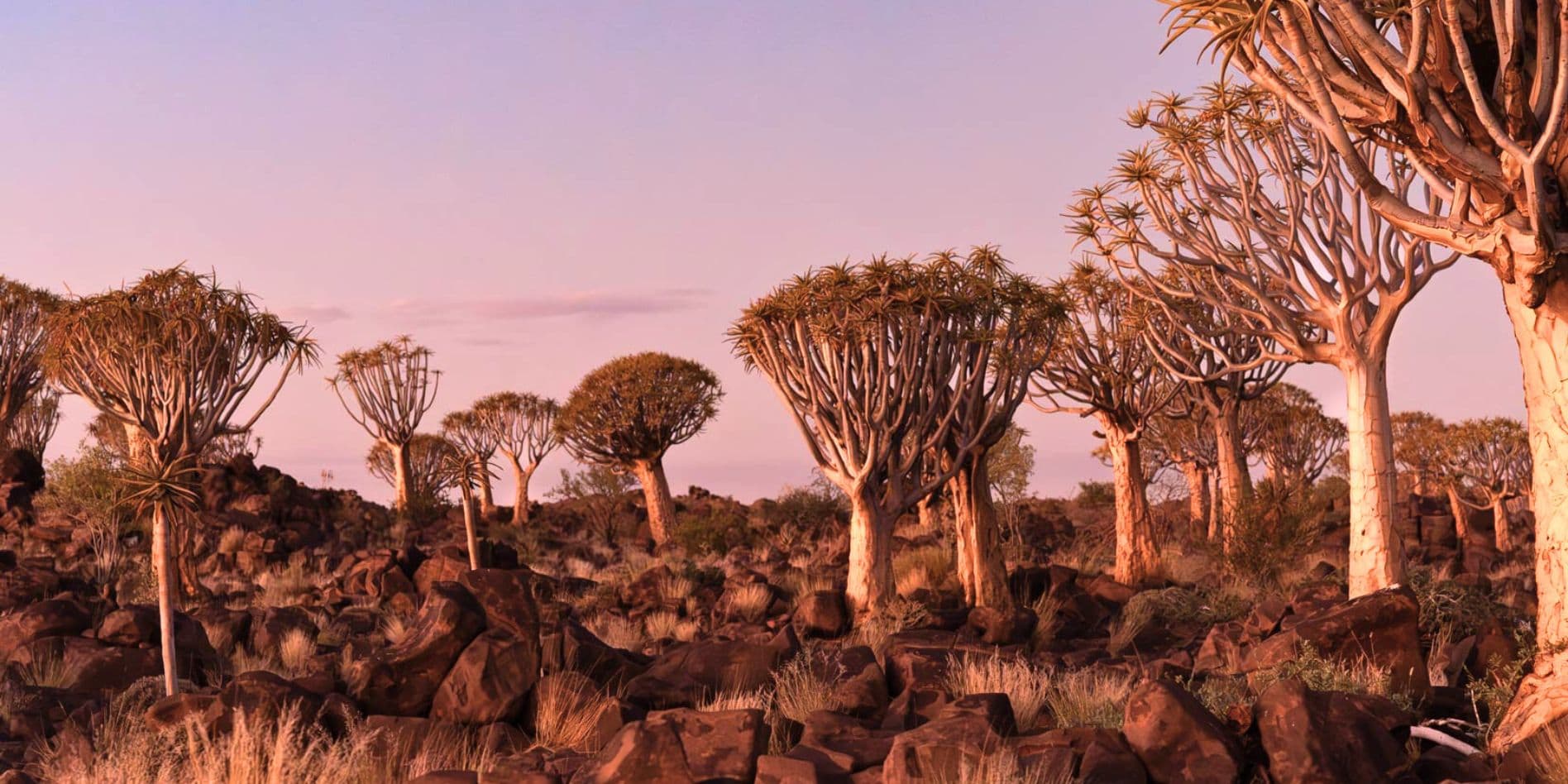At the start of our road trip through Namibia, a local’s suggestion led us to the Quiver Tree Forest near Keetmanshoop.
Despite the scant online information regarding visit logistics, we were determined to experience the iconic aloe dichotoma. That’s the Latin term, but we’ll stick to calling them Quiver Trees—it sounds friendlier and less like we’re in a botany exam.
This guide, created from our firsthand experience, aims to clarify the how-tos of visiting this photographer’s haven and the nearby Giant’s Playground, ensuring you capture the perfect golden glow of Namibia’s Quiver Tree Forest on camera.
👀 What You’ll Find in this Quiver Tree Forest Namibia Article:
- ❗️ In A Hurry? Key Info: Visiting the Quiver Tree Forest and Giants Playground
- 🗺️ Interactive Map: Quiver Tree Forest and Giants Playground
- 💡 Essential Visitor Tips
- 📸 Photography Tips
- ⛺️ Where to Stay
- 🤔 Frequently Asked Questions
(Click any section above to jump ahead)
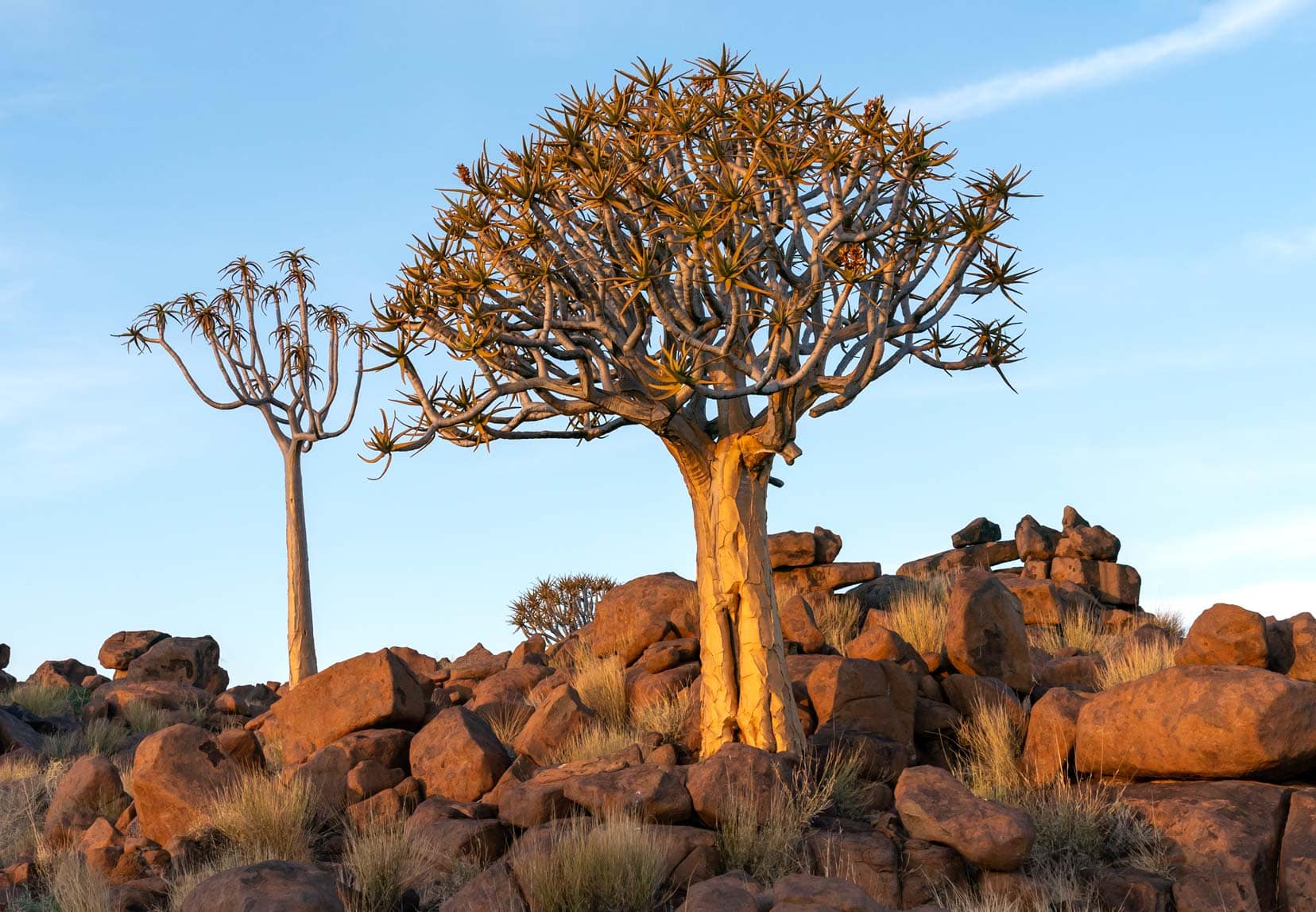
❗️In A Hurry? Key Information for Visiting the Quiver Tree Forest and Giants Playground
- Permit Acquisition: Obtain a permit at Quiver Tree Forest Rest Camp reception. The permit covers entry to the Quiver Tree Forest and the Giant’s Playground.
- Quiver Tree Forest Entrance Fee: The cost of the permit is N$110 Namibian Dollars (about $7.50 USD, £6.00 GBP, $11.50 AUD)
- Best Viewing Time: Sunset for a golden hue on the trees at Quiver Tree Forest. The best season to visit to see the Quivertrees in bloom is winter, in June and July.
- Giant’s Playground Visit: Late afternoon, spend an hour before returning to the Quiver Tree Forest for sunset.
- Getting There: 14 km from Keetmanshoop along the C17, follow signs to Quiver Tree Forest Rest Camp for permits.
- Wildlife Spotting: Look for rock dassies, ground squirrels, and possibly meerkats.
- Photography: Capture the dolerite formations at Giant’s Playground with the surrounding quiver trees then arrive at the Quiver Tree Forest for golden hour shots.
- Accommodation: Camp at Quiver Tree Forest Rest Camp or Keetmanshoop Self-Catering for convenience.
For all the fine details and lots of pics, browse on.
Map: Quiver Tree Forest And Giant’s Playground

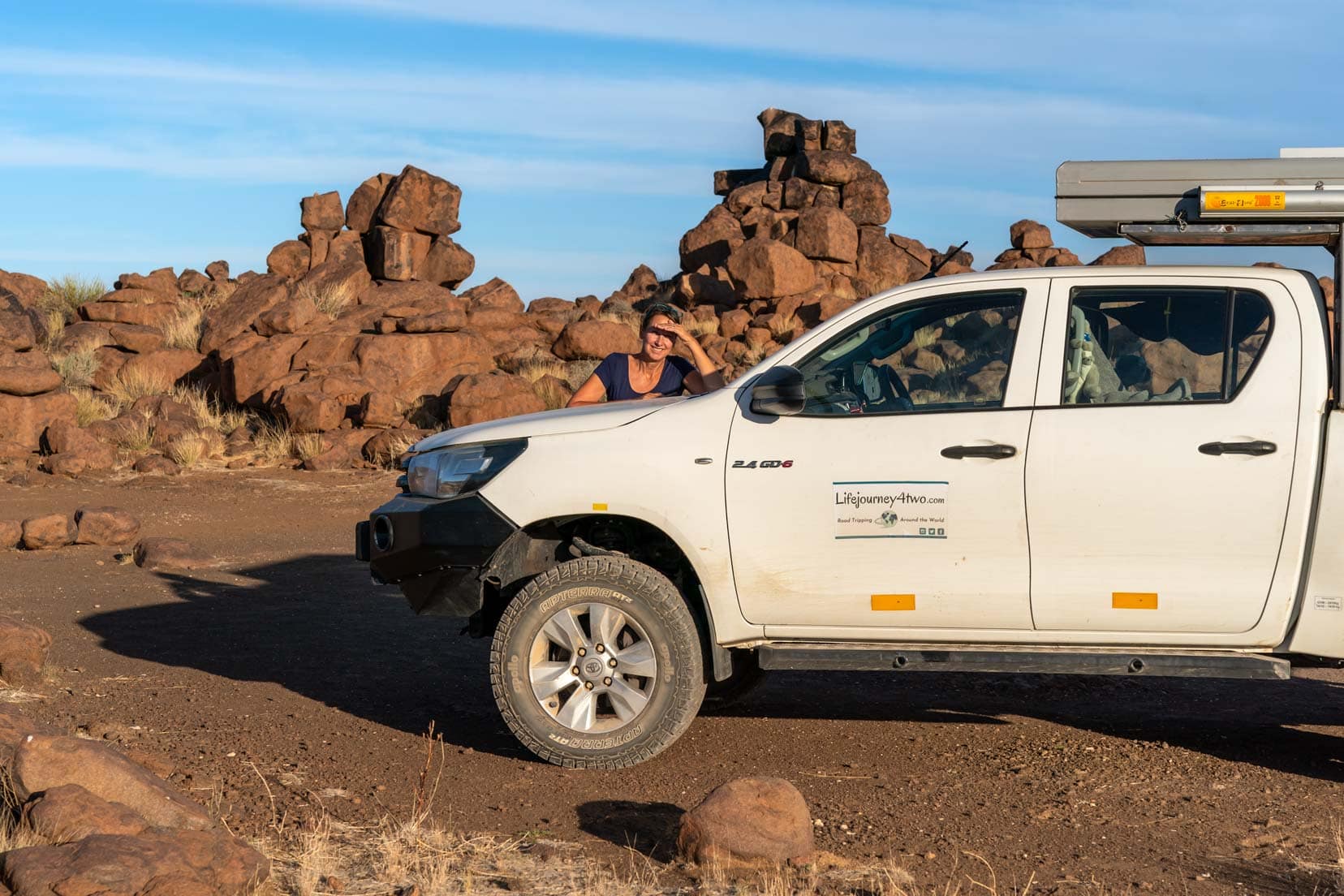
Planning a Trip to Namibia?
- 🚗 Hiring a car? We recommend getting a quote from DiscoverCars
- 🚐 Hiring a campervan? We recommend Motorhome Republic
- ⛑ Arranged your travel insurance? Compare quotes from World Nomads & Safetywing
- 🪪 Order your International Driver’s Licence online here
- 🏩 Booked your accommodation? We use Booking.com to find the best deals
- 🐾 Is someone pet-sitting for you? 🐾 We use and love TrustedHousesitters
- (Get 25% off at checkout for new memberships with our discount code: LIFEJOURNEY25)
Essential Tips for Visiting Quiver Tree Forest Namibia
- Permit Acquisition: Buy a permit at the Quiver Tree Forest Lodge reception. This permit covers both the Quiver Tree Forest and the Giant’s Playground. The permit costs N$110 from sunrise to sunset. You can also buy a nighttime photography permit that costs N$500.
- Onward Journey: With your permit, drive to the Quiver Tree Forest within the farm grounds (follow the loop around to the forest) or head back out onto the main road and continue on to the Giant’s Playground that you’ll see on your right – about 4.5 km / 3-minute drive.
- Best Viewing Time: The Quiver Tree Forest is most captivating at sunset, with a golden hue enveloping the trees.
- Giant’s Playground Visit: Aim for an early evening visit, spending about an hour before heading back to the Quiver Tree Forest for sunset.
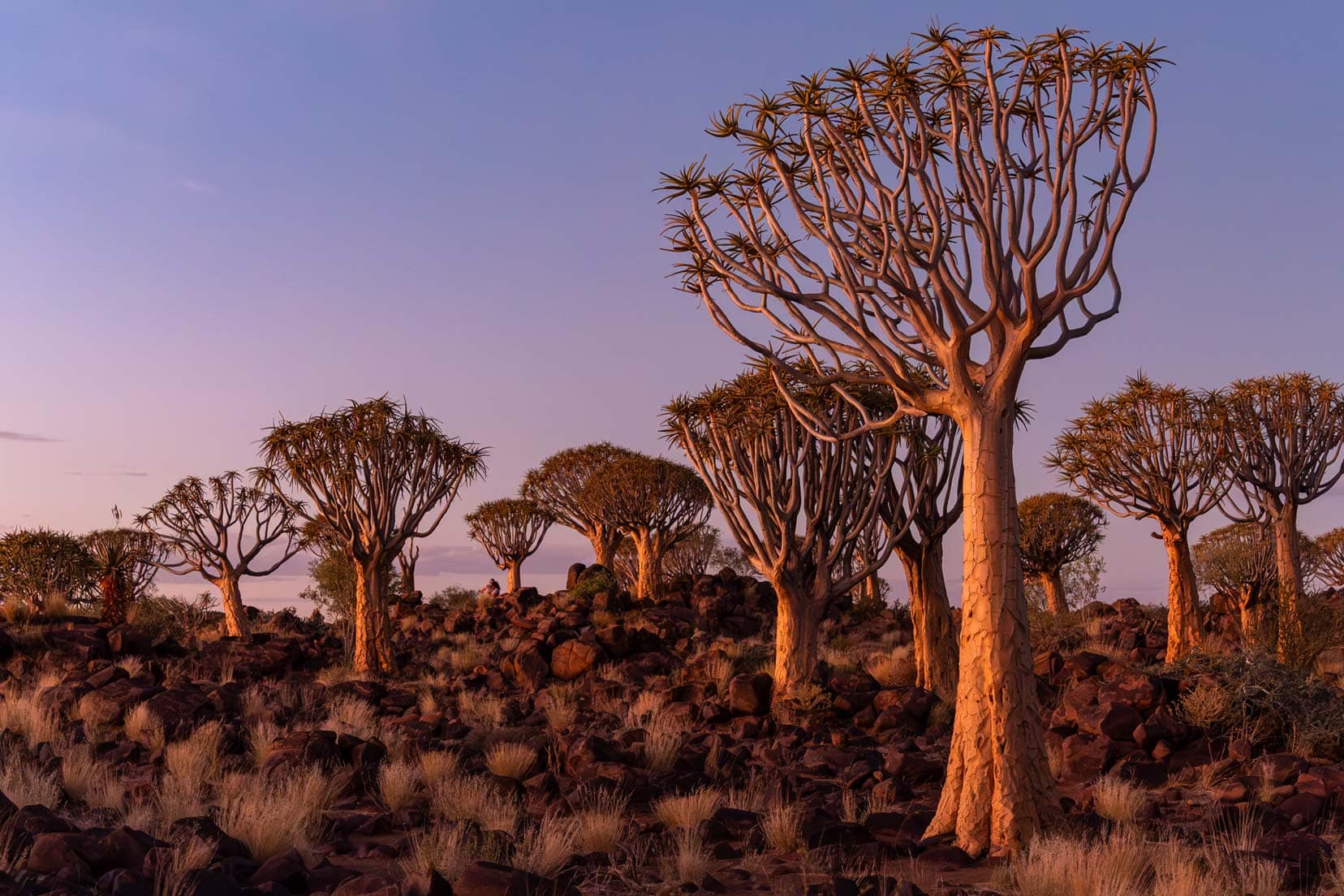
Getting to The Quiver Tree Forest & Giants Playground
The Quiver Tree Forest is 14 kilometres from Keetmanshoop along the C17. A sign on your left from Keetmanshoop directs you to a dirt track leading to the Quiver Tree Forest Rest Camp. Buy your permit at the reception before exploring both sites.
We recommend stopping at the reception to purchase your permit before returning to the main road to drive a few minutes north to the Giant’s Playground.
After exploring the Dolomite rocks, return to the Quiver Forest Rest Camp, drive straight past the reception and take the loop to the carpark (see map). Arrive at the Quiver forest an hour or so before sunset to witness the golden hues reflecting off the trees.
You can find Keetmanshoop sunset times on The Time and Date website here
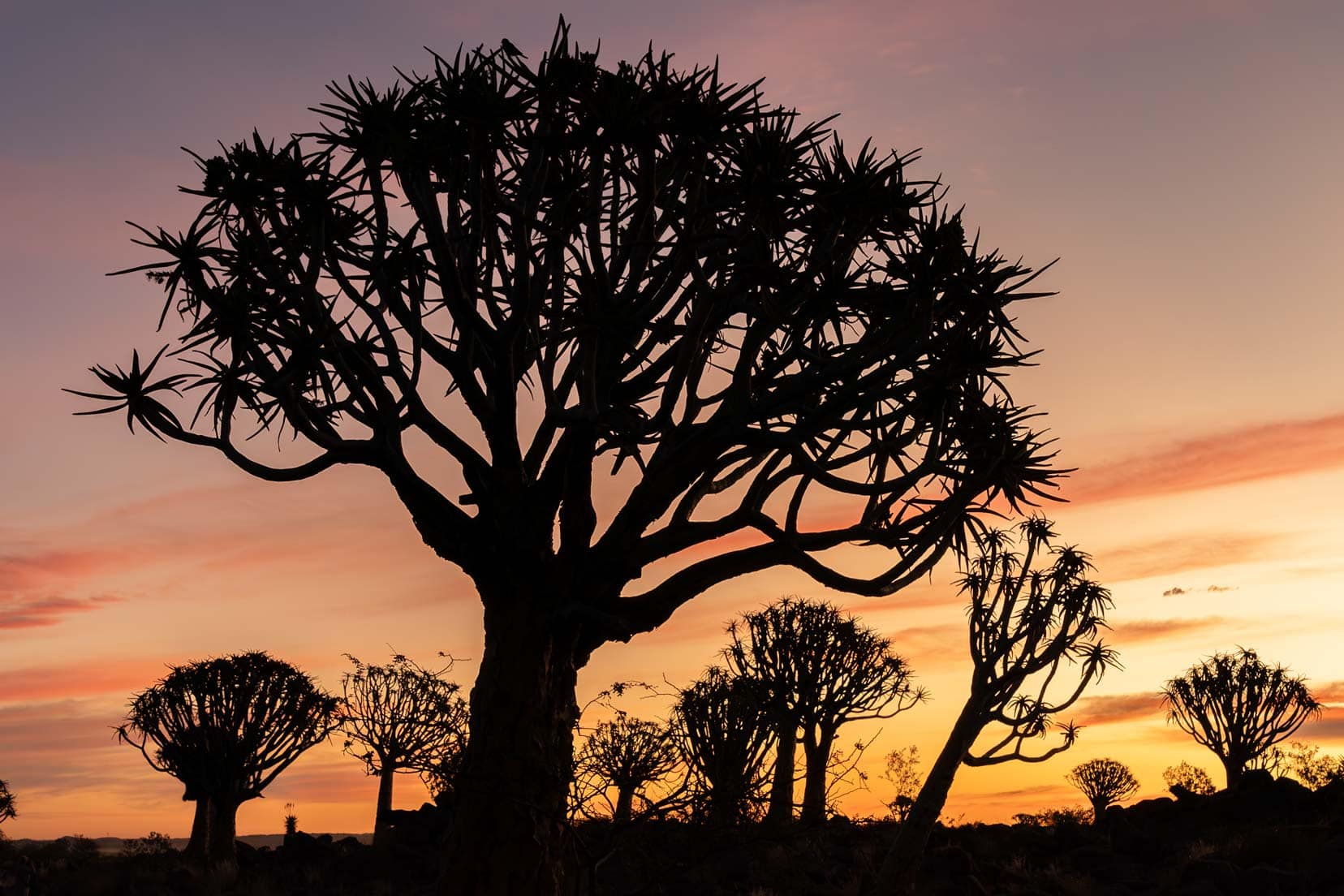
Exploring Quiver Tree Forest: A Visual Spectacle
The forest houses legally protected quiver trees, with some aged between 200-300 years.
Grouped closely, they create a visually appealing scene, especially at sunset. While there, you might spot rock dassies (rock hyrax) amidst the rocks.
Quiver Trees: A Closer Look
So, what is so special about quiver trees?
- National Treasure: The quiver tree is Namibia’s National Tree and a protected species, underlining its importance in the region.
- Historical Significance: The name ‘quiver tree’ originates from the San bushmen’s practice of hollowing out the branches to craft quivers for their arrows.
- Floral Phenomenon: Quiver trees have a delayed flowering age, beginning at 20-30 years old, which leads to a spectacular blooming period from June to July. During this time, the bright yellow flowers add a vibrant hue to the landscape and attract many insects, birds, and mammals.
- Survival Specialist: Adapted to arid conditions, quiver trees can store water in their trunks and leaves, showcasing remarkable resilience and an exemplary adaptation to their harsh environment.
- Eco-Significance: They play a vital role in their ecosystem, providing shelter and food for various animals. Their flowers are a nectar source for birds and insects, while their sturdy branches offer nesting sites for sociable weavers.
With these distinctive features, the Quiver Tree is a testament to nature’s resilience and the harmonious intertwining of natural and cultural heritage in Namibia. Its presence adds a unique charm to the Quiver Tree Forest, making it a great stop on any Namibia road trip.
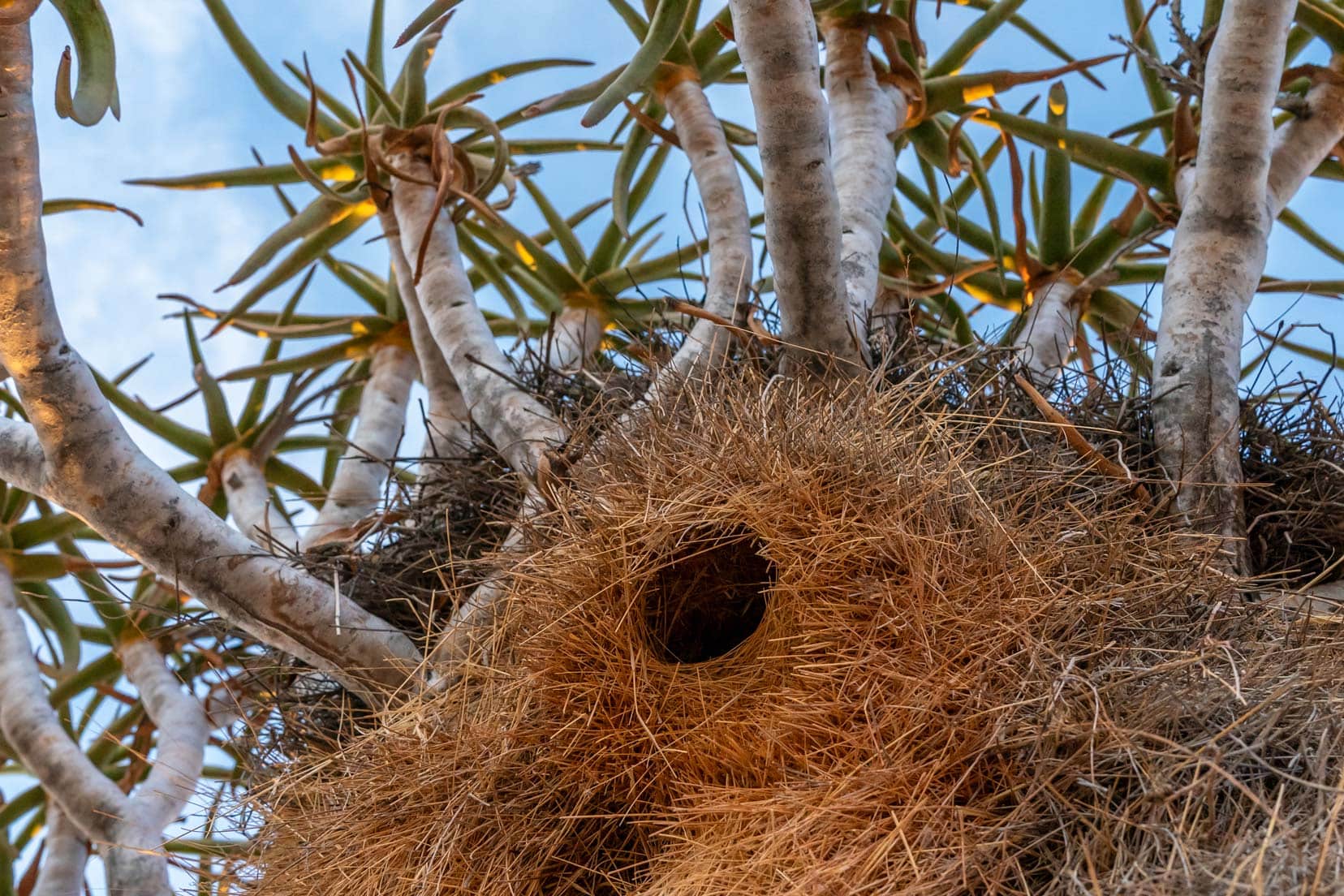
Wildlife Encounters in the Forest
We had the chance to see some dassies (rock hyrax) darting among the trees. You might also come across ground squirrels, adorable creatures that stand on their hind legs, often freezing if they notice you
Though we didn’t spot any meerkats, a stay at Kanaan Desert Retreat increases your odds, thanks to a resident group accustomed to humans. Delve into our delightful meerkat encounters at Kanaan, complete with a captivating video.
You can camp at the Kanaan Retreat, where you look out over the vast desert savannah and the Tiras Mountains or book a luxury tent.
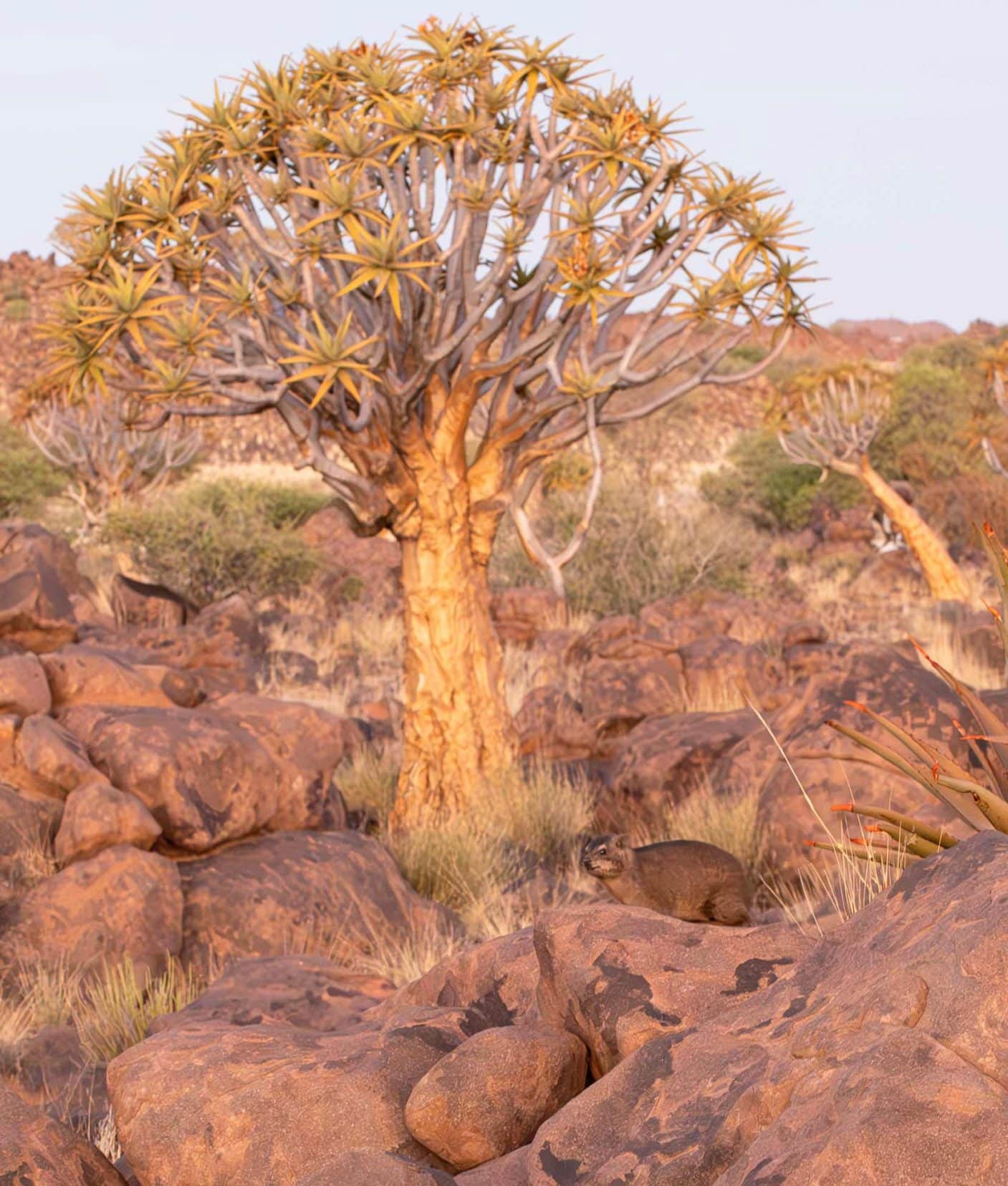
Giant’s Playground: An Ageless Marvel
The Giant’s Playground is a remarkable collection of 160-180-million-year-old dolerite boulders stacked naturally over time.
These incredible dolerite rock formations make great subjects for photographers. You’ll also find quivertrees here, poking through the rocks as if vying for attention.
The Giant’s Playground Explained:
- The scene at the Giant’s Playground results from a dolerite swarm formation. This process began deep beneath the Earth’s surface where heat melted rocks, forming magma.
- This magma moved upwards through cracks towards the Earth’s crust, cooling and solidifying over time to form dolerite rock.
- Repeated occurrences of this process led to multiple dolerite formations close to each other, creating a dolerite swarm. Erosion over millions of years exposed the dolerite formations we see today.
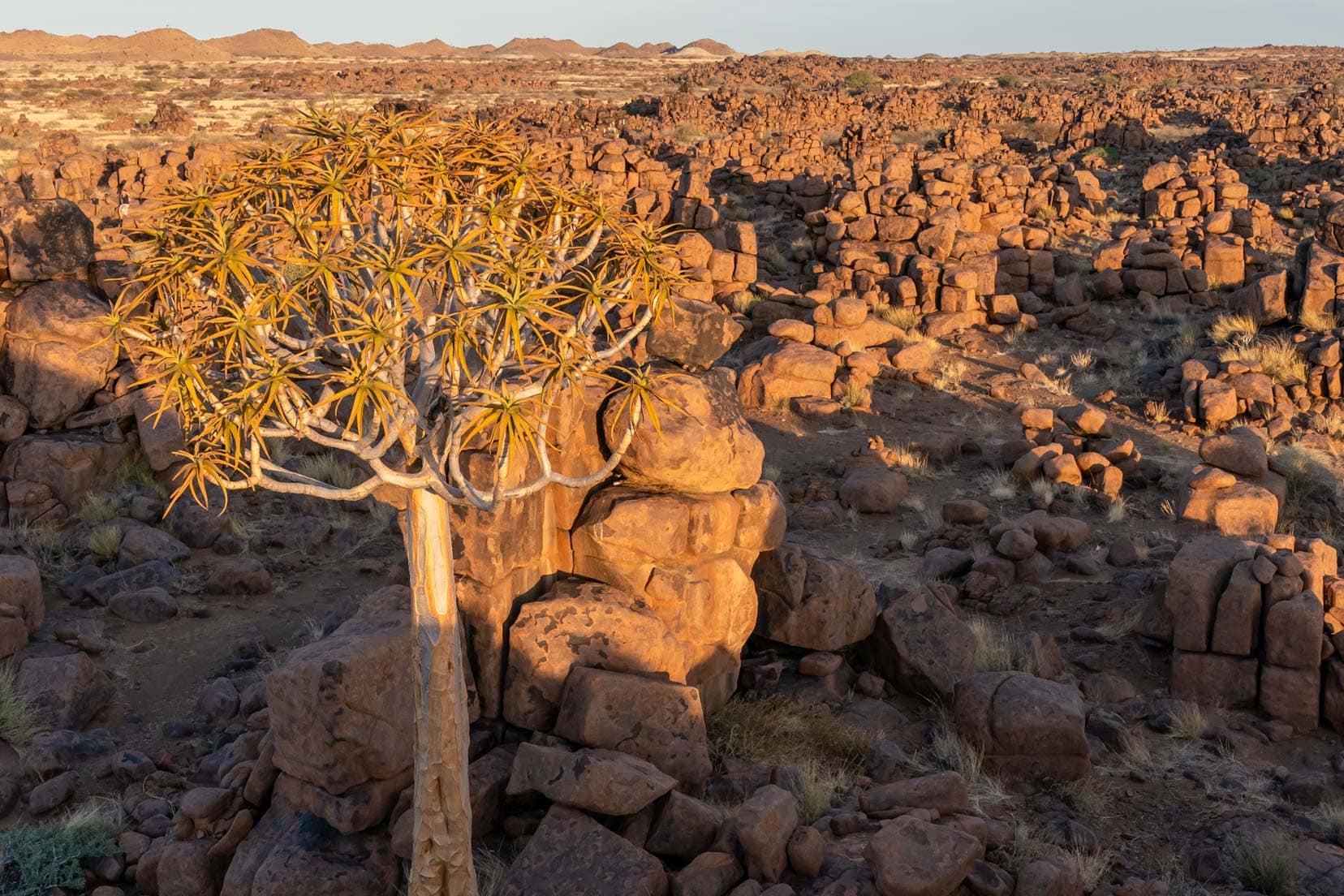
The name “Giant’s Playground” comes from how these boulders are stacked, resembling blocks in a playground. The surrounding area near Keetmanshoop also features similar dolerite formations, covering about 180,000 square kilometres.
The trail around the Giant’s Playground offers a glimpse into this geological wonder, making it a worthwhile stop on your Namibian adventure.
💡Visitor Tip: If you are visiting in the heat, make sure to take a water bottle on the trail around the area and have a hat and sunscreen.
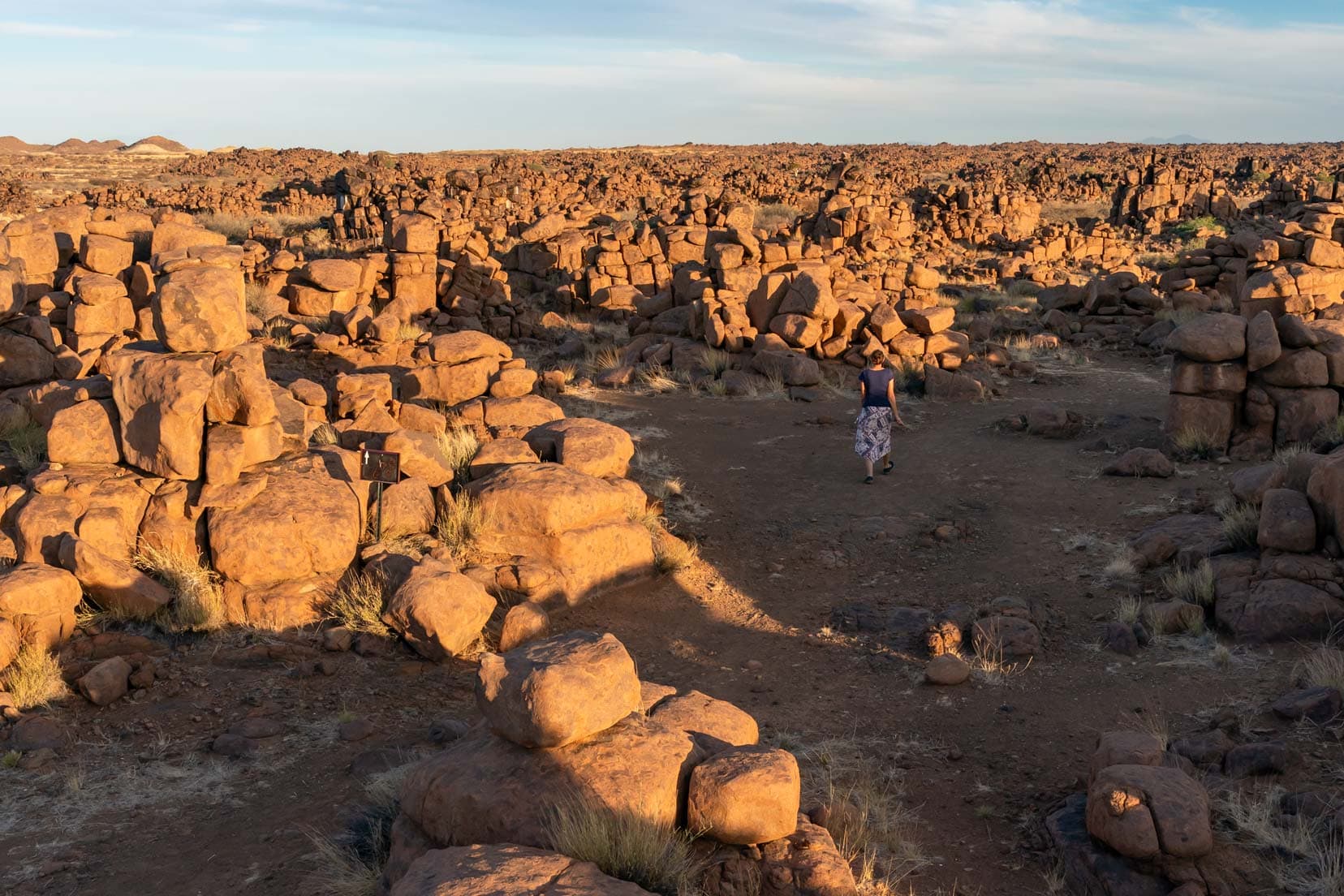
As we revelled in the maze-like grandeur of the Giant’s Playground, our lenses captivated by the dolerite formations, time seemed to play tricks on us.
Before we knew it, the sun was flirting with the horizon, urging us to dash back to the Quiver Tree Forest.
💡Visitor Tip: while the Playground can steal hours with its geological wonders, keep one eye on the sun’s path. The forest’s sunset spectacle is a visual symphony not to be missed – and we nearly did! So, factor in more time than you think you’ll need.
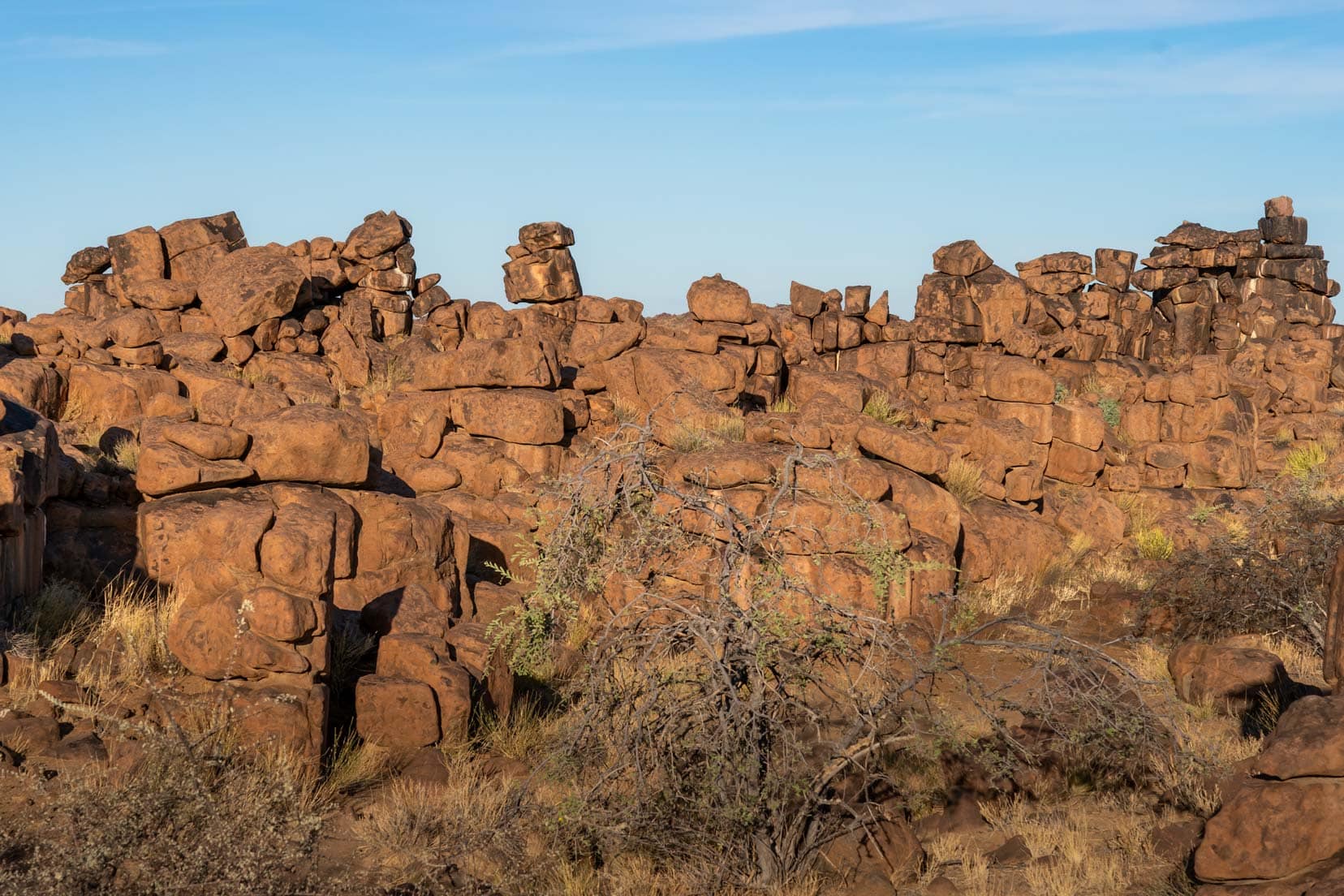
Photography Tips: Telling the Story
For the best opportunities for Quiver tree forest photos, these are suggested photography tips:
- Golden Hour: Arrive during the golden hour for those soft, warm hues.
- Wide-Angle Lens: Use a wide-angle lens to capture the vastness of the forest.
- Play with Perspectives: Get low or high to find unique angles.
- Patience: Wildlife may pop into the frame—be ready!
For more photography adventures in Namibia, check out our guide on How to Photograph Sossusvlei and capture the essence of the desert like never before.
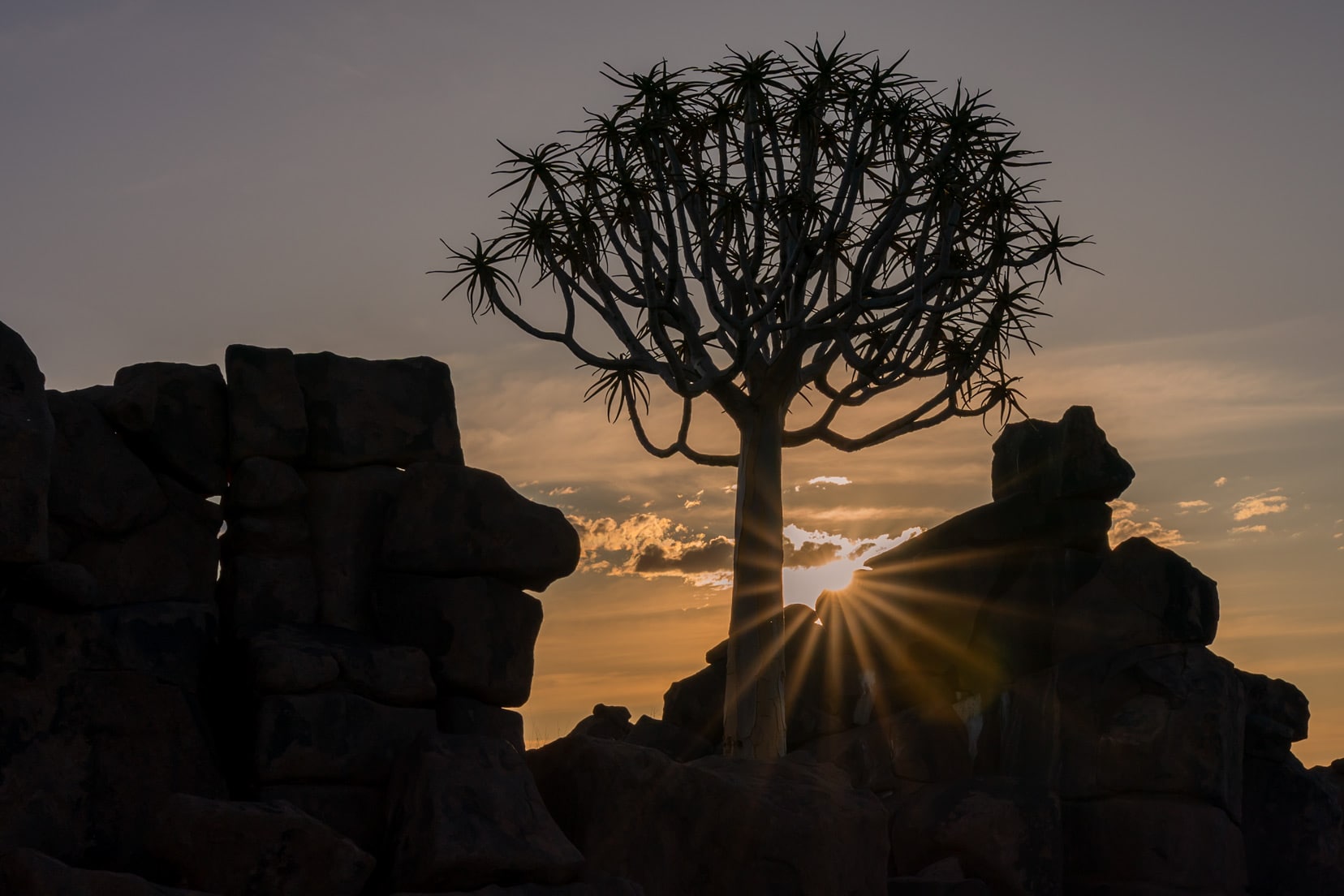
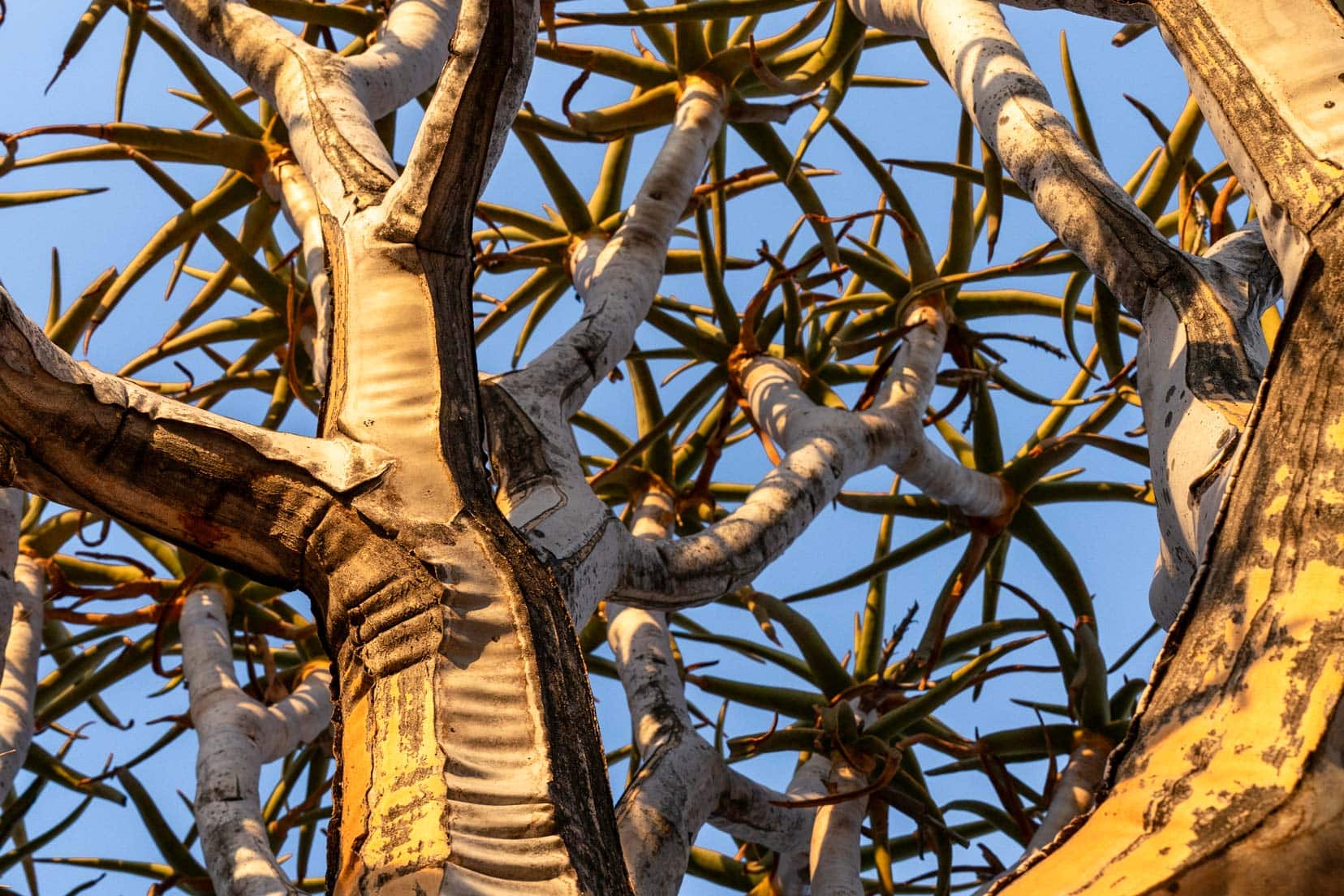
Where to Stay Near The Quiver Trees
The following two accommodation options include camping or guest house accommodation at the Quiver Tree Restcamp and self-catering in Keetmanshoop, where we stayed.
Quiver Tree Forest Rest Camp
The Quiver Tree Forest Rest Camp is a good place to camp for a night if you want to explore the majestic Quiver Tree Forest and the Giant’s Playground. Located just 13 km from Keetmanshoop on the M29, the rest camp is conveniently situated and has various accommodation options.
However, if you aren’t camping, we would recommend staying in Keetmanshoop Self-catering if you aren’t camping; the prices are more reasonable, and you are guaranteed a friendly service.
In fact, the price for a double room there is about the same for a night of two people camping at Quiver Tree Forest.
Reviews are mixed for the Quiver Tree Forest Rest Camp – with many campers reporting tired amenities.
However, the main thread of reviews seems to be the unfriendly staff – and we can only corroborate that. The woman at reception was quite curt and not very helpful with information about the Forest tickets.
Camping fees: N$300 per person (Our Tip: a double room with a mini kitchenette in Keetmanshoop is about N$600). There aren’t marked camping sites, and there is no need to book – you can just turn up.
Our Keetmanshoop Stay – Self-Catering
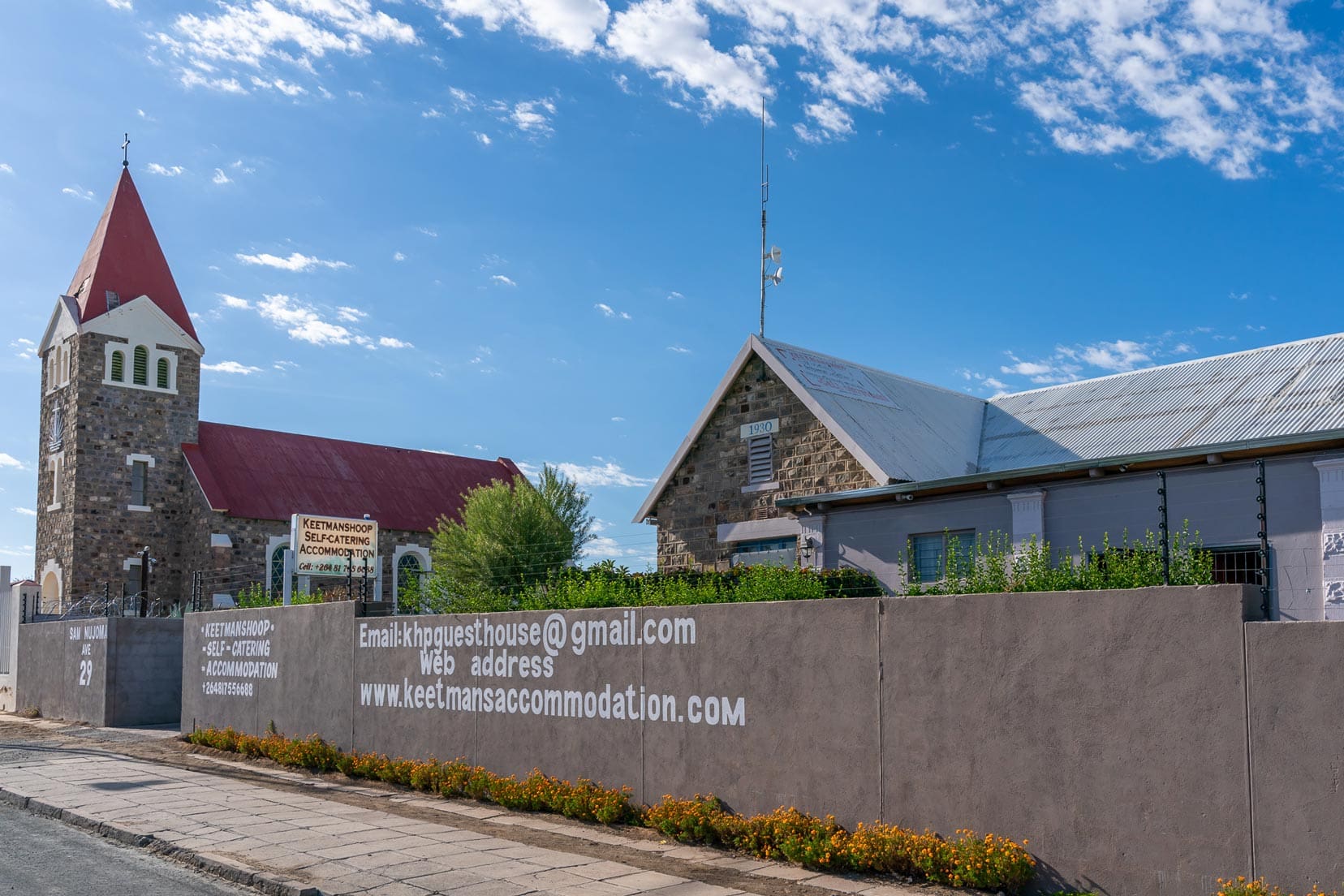
After months of overlanding across Botswana, culminating in a visit to the mesmerising Kgalagadi Transfrontier Park, we sought a respite from camping.
Our find was Keetmanshoop Self-Catering.
Here’s what we enjoyed:
- Air-conditioned rooms
- Convenient kitchenette
- BBQ facilities
- Free WIFI
- Flat-screen TV with streaming channels
- A short stroll to the local Spar
Our friendly host, Dries, pointed us to the Quiver Tree Forest and capturing the scenic allure of this Namibian gem was a delightful experience.
🛌 Keetmanshoop Self-Catering Guesthouse | ⭐️ 9/10 Superb Reviews | Book your stay here.
Keetmanshoop Self-Catering Reviews
“Great little place in Keetmanshoop. Nicely decorated. The owner was so friendly and helped us when we had a problem with our car. Would definitely recommend.” Shannon, UK Oct 2023
“We needed a good place to stay after a long day’s drive. This was perfect. … Great value for money.” Russell, Australia Oct, 2023
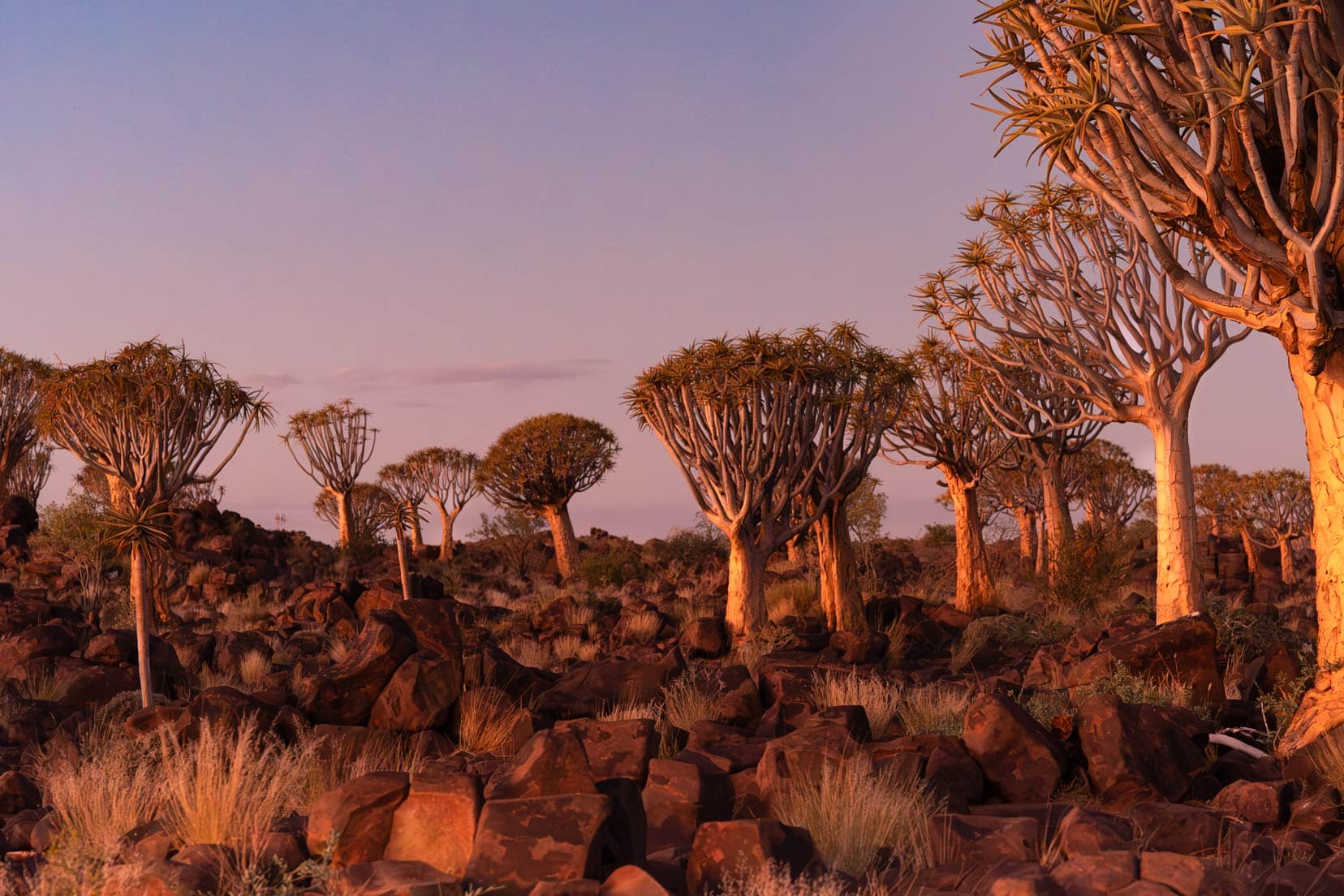
FAQs on Quiver Tree Forest and Giants Playground
1. Where is the Quiver Tree found?
The Quiver Tree is found mainly in the southern to central parts of Namibia and the northwest of South Africa.
2. What is the Quiver Tree in Afrikaans?
In Afrikaans, the Quiver Tree is called kokerboom.
3. What is the Quiver Tree entrance fee?
The entrance fee is N$110, obtained by purchasing a permit at the Quiver Tree Forest Rest Camp reception, which covers access to both the Quiver Tree Forest and the Giant’s Playground.
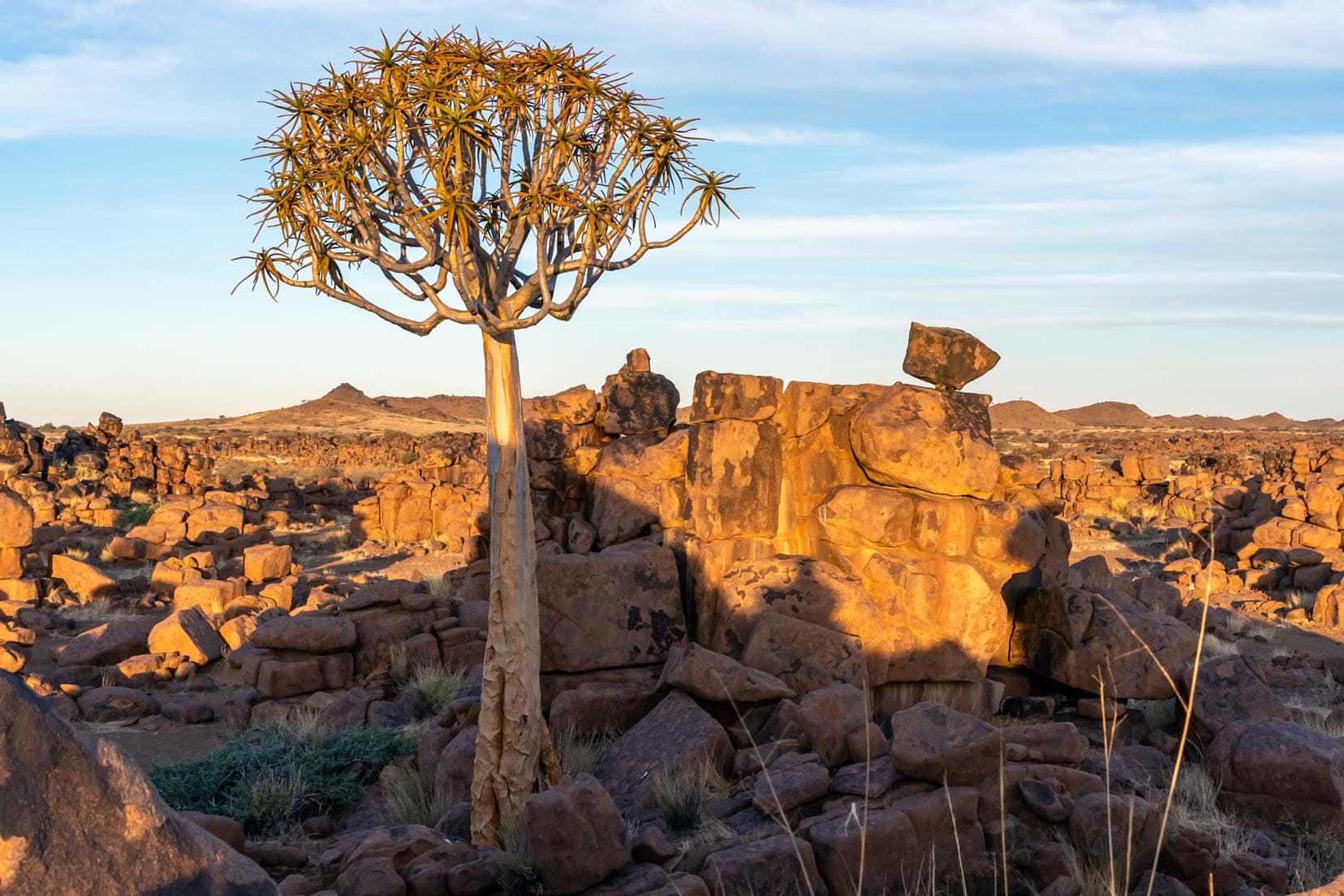
4. What is the Quiver Tree Forest and Giants Playground?
The Quiver Tree Forest and Giants Playground is a natural attraction located in southern Namibia, approximately 14 km northeast of Keetmanshoop. The site consists of a forest of quiver trees and unusual dolerite rock formations.
5. What are Quiver Trees?
Quiver Trees, also known as Aloe dichotoma, are tall, branching trees with unique succulent leaves. They are called “quiver trees” because, in the past, the San people used their branches to make quivers to hold their arrows.
6. Where is the Quiver Tree Forest located?
The Quiver Tree Forest is located in southern Namibia, northeast of Keetmanshoop, and can be easily accessed from Windhoek, the capital of Namibia.
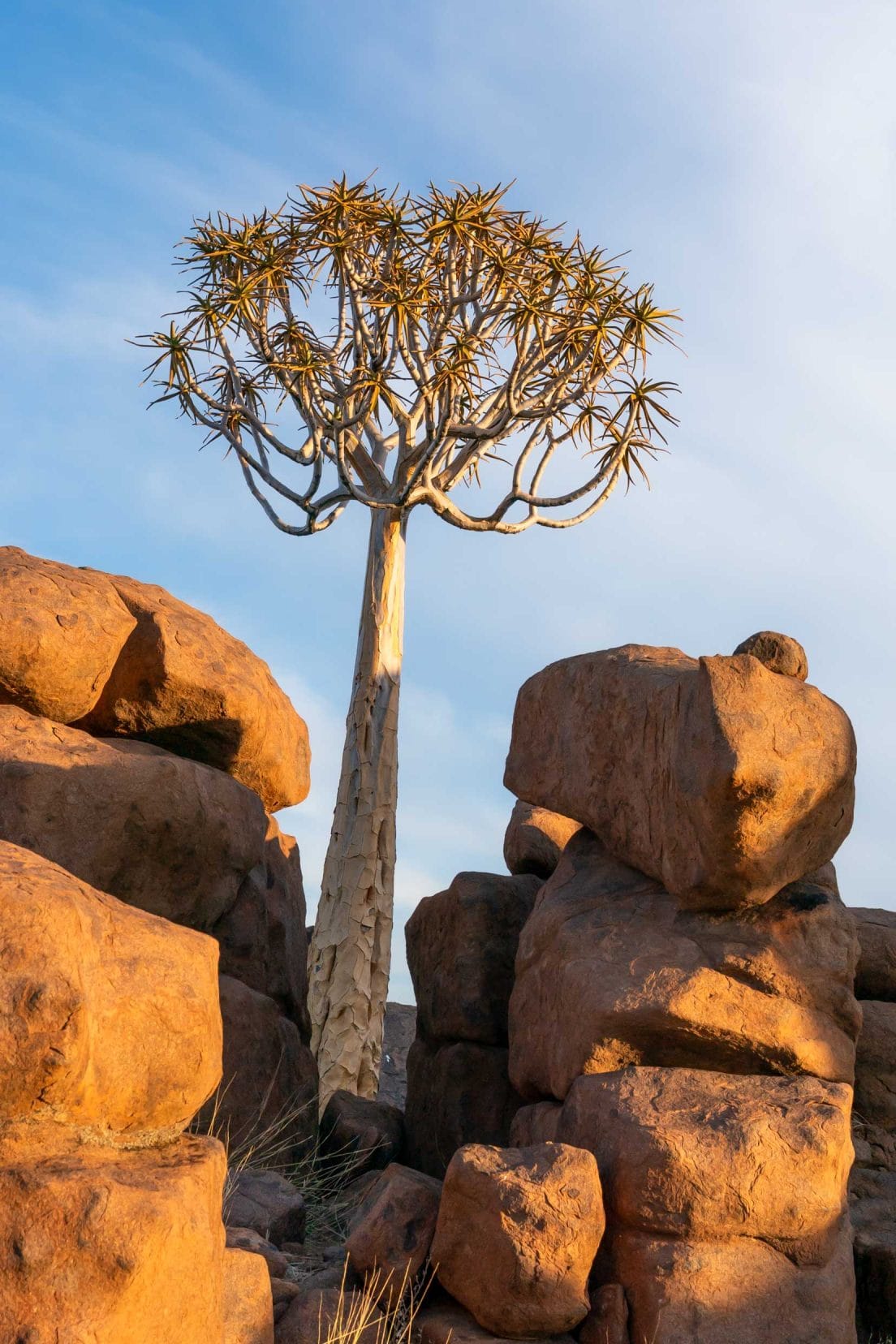
7. Is the Quiver Tree Forest a national monument?
Yes, the Quiver Tree Forest and Giants Playground have been declared national monuments of Namibia. This recognition acknowledges their significance and ensures their preservation for future generations.
8. What can I expect to see at the Giants Playground?
The Giants Playground area within the Quiver Tree Forest features impressive dolerite rock formations. Visitors can explore the unique geological formations and witness the fascinating patterns and shapes created by millions of years of erosion.
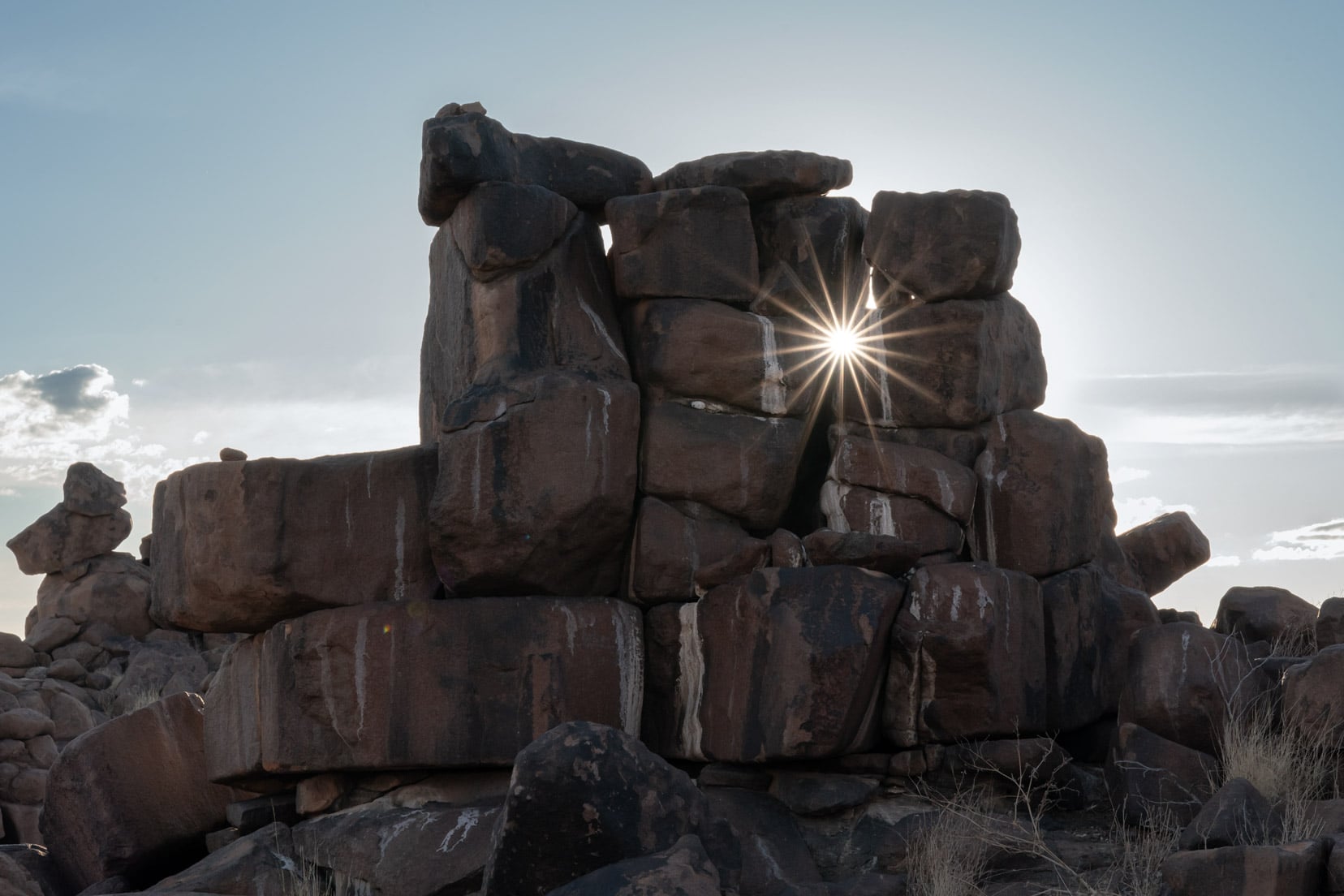
Namibia’s Quiver Tree Forest & Giant’s Playground … That’s a Wrap
This guide should equip you with the essentials for a fulfilling exploration of the Quiver Tree Forest and the Giant’s Playground, marking a memorable chapter in your Namibian adventure.
But Namibia’s Quiver Tree Forest and Giant’s Playground are just the beginning of the country’s awe-inspiring offerings. Our journey through Namibia was a tapestry of memorable encounters with nature and culture.
Feel the desert’s heartbeat on a Living Desert Tour in Swakopmund or step back in time at Kolmanskop Ghost Town. You can discover all the other adventures awaiting you in Namibia on our Explore Namibia Page.
👉 Grab our free road trip planner to help map out your next adventure.


Pin and save for later
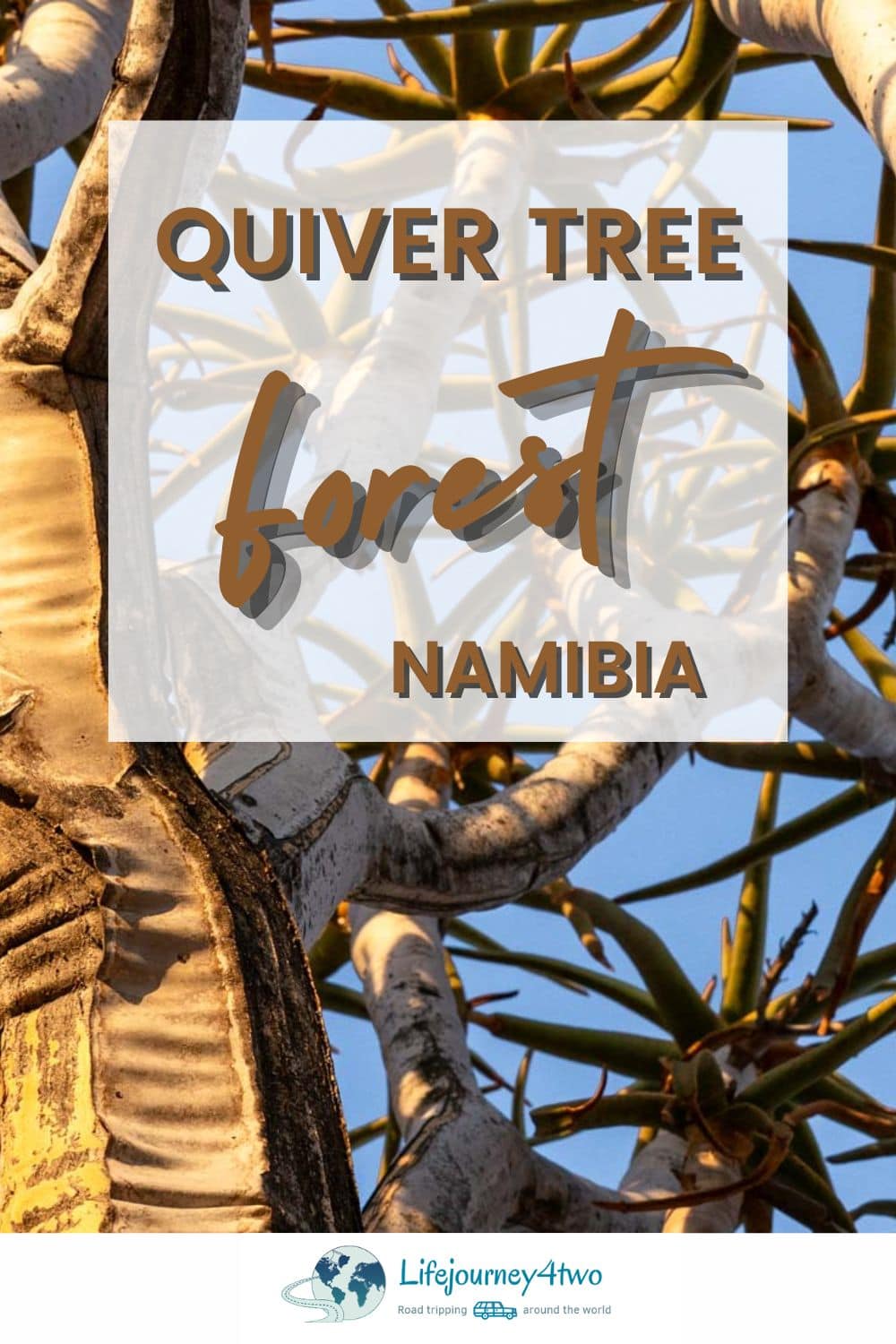
We’d love to hear your stories! Have you visited Namibia’s Quiver Tree Forest? Drop your tales and tips in the comments and join our community of explorers.
Planning Your Travels?
These are the travel resources we recommend and use when planning our trips.
- 🚘 Car Hire: We use DiscoverCars.com
- Motorhome/Campervan Rental: We highly recommend the Motorhome Republic
- 🪪 Order your International Driver’s Licence online here
- 🛏 Book Accommodation: We use Booking.com to find accommodation that suits our budget
- 🐶 Pet Sitting/Pet Sitters: Check Out TrustedHousesitters here (Use our Discount code: LIFEJOURNEY25 for 25% off. )
- Activities and Experiences: Get Your Guide and Viator
- Travel Insurance: Safetywing or World Nomads
- 🥾 Travel Gear and Accessories: Check out our top picks here — Lifejourney4two page on Amazon
For a more thorough list, visit our Travel Resources page here.

